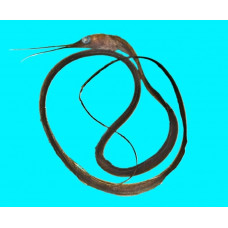Latin name
Nemichthys scolopaceus
Other name
Deep sea duck
Identification
The body of the Slender Snipe Eel is long and slender, with an elongated head, the jaws resembling the long straight beak of a bird. The rear end of the body is narrow and ends in a long filament. The backbone has about 750 vertebrae. Over the course of evolution, the anus has moved forward and is now located at the throat. Like other eels, it undergoes a leptocephalic stage of development. In the period following metamorphosis and the onset of sexual maturity, they possess long, slender jaws studded with extremely fine, frequent teeth. Sexually mature males lose their teeth and undergo a drastic change in appearance (which has often led to their separation into separate species). A similar transformation may occur in females.
Features of fish fins
Dorsal spines (total): 0; Anal spines: 0.
They have about 350 rays in their dorsal fin. The tail fin is indistinguishable. The anal fin has about 320 rays.
Fish colouring
The body of the Slender Snipe Eel is dark brown or gray, often darker underneath. The anal fin and the tips of the pectoral fins are almost black.
Distribution
Widespread in tropical and warm temperate waters of all oceans.
Habitat
A marine bathypelagic species. Usually found at depths of up to 500 meters. It has been caught near the surface in the Mediterranean, but only in winter when the temperature of the surface layers drops to 13-15°C and below.
Size
The body length of these fish reaches 130 cm, the tail part is stretched into a long thread, while the body height of this eel is no more than 2 cm, making it probably the thinnest fish in the world. Their life expectancy is up to 10 years.
Behavior
Juveniles of this species have been observed at depths of 100 meters in the Mediterranean and do not make vertical migrations. Adults inhabit depths of up to 4,000 meters in the North Atlantic and make daily migrations.
Food and feeding habits
Slender snipe eels hover motionless in the water column waiting for their prey - krill, shrimp.
Reproduction
Reproduction is by spawning, with females laying eggs and males simultaneously releasing sperm into the water. They spawn only once in their lives, as they die after spawning. Their larvae are leaf-shaped and actually shrink in size before developing into adults.
Fishing
This species is not commercially important.
Relationship with a person
Harmless.
| Classification | |
| Phylum | Chordata |
| Class | Actinopterygii |
| Squad | Anguilliformes |
| Family | Nemichthyidae |
| Genus | Nemichthys |
| Species | N. scolopaceus |
| Features | |
| Conservation status | Least Concern |
| Habitat | Pelagic |
| Life span, years | 10 |
| Maximum body weight, kg | No information |
| Maximum length, cm | 130 |
| Sailing speed, m/s | No information |
| Threat to people | Edible |
| Way of eating | Planktonophage |
Slender snipe eel
Tags: slender snipe eel

